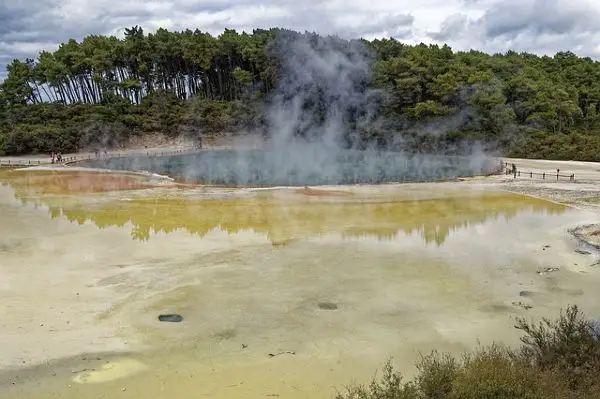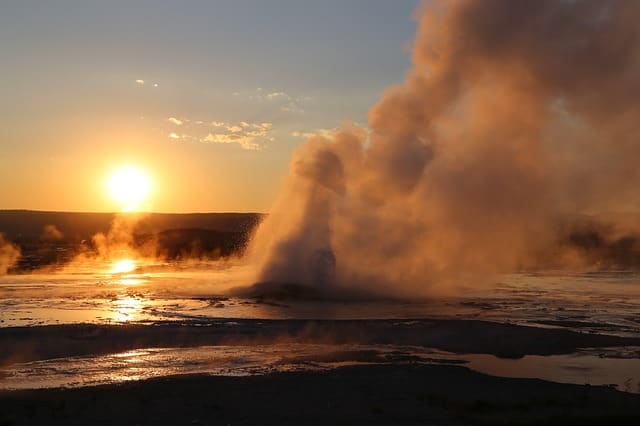
AFRILCATE
WHAT IS EVAPORATION?
Evaporation is the spontaneous transition of a substance from the liquid phase to the gaseous phase.
It occurs below the boiling temperature of the liquid.
It is the primary pathway that aids the movement of water into the water cycle as atmospheric water vapor.
Therefore, evaporation is an essential part of the water cycle.
Evaporation accounts for 90 percent of the moisture in the atmosphere.
The remaining 10 percent is contributed by plant transpiration.
Evaporation is different from boiling. It occurs only at the surface of the liquid.
Water boils at 100◦C (212◦F) but it begins to evaporate at 0◦C (32◦F). This means that evaporation takes place over a wide range of temperatures.
Evaporation occurs at a very slow rate but as the temperature increases, the rate of evaporation increases also.

WHAT CAUSES EVAPORATION?
- Surface Exposure
- Heat
- Saturation (humidity)
- Air Pressure
1. Surface Exposure
Evaporation occurs when the surface of the liquid is exposed.
It doesn’t occur throughout the whole body or volume of the liquid but only at the liquid’s surface.
For instance, if a bottle of whiskey is open, the liquid will begin to evaporate with time.
A tightly corked bottle of methylated spirit will contain the same volume of liquid content but when the cork is removed, the content of the bottle reduces gradually.
The wider the opening or exposure, the faster the evaporation.
2. Heat
Heat (thermal energy) is necessary for evaporation to occur.
Liquids evaporate faster when it is heated because the added heat results in an increase in the kinetic energy of the water molecules.
Continuous heating makes it possible for a greater fraction of the liquid molecules to break the intermolecular bond and escape from the surface to the atmosphere.

evaporation in hot spring
3. Saturation (Humidity)
If the air is saturated with air particles, It will be difficult for evaporation to occur.
If the humidity is 100 percent, it means that the air is saturated with water.
At this point, evaporation can’t take place.
4. Air Pressure
Air pressure also affects evaporation.
If air pressure is high on the surface of a body of water, then the evaporation process will be drastically reduced.
The pressure pushing down on the water makes it difficult for water to escape into the atmosphere as vapor.
Storms are often high-pressure systems that prevent evaporation.
EVAPORATION PROCESS
The collision of molecules leads to the transfer of energy from one to the other.
When a molecule near the surface absorbs enough energy to overcome the vapor pressure, it escapes and enters the surrounding air as a gas.
During evaporation, the energy removed from the vaporized liquid will reduce the temperature of the liquid, resulting in a cooling effect which is termed evaporative cooling.
Evaporation will continue until an equilibrium is reached.
At equilibrium, the rate of evaporation of the liquid equals its condensation rate.
On a global scale, the amount of water evaporating from the earth’s surface is roughly the same amount delivered back to the earth as precipitation although, a variation may exist due to geographical location.
Evaporation is one of the three main processes in the earth’s water cycle. The other two being condensation and precipitation.
If the liquid is in an enclosed environment, it will evaporate until the surrounding air is saturated.
Evaporative cooling alongside convection help balance the earth’s surface from the overheating effect of solar radiation and greenhouse emission.
EXAMPLES OF EVAPORATION
Evaporation is a common phenomenon. Let’s discuss some common examples.
- Evaporation of perspiration from the body: sweat evaporates from the body taking away the body heat thereby, causing a cooling effect.
- Drying clothes under the sun: wet clothes get dried when placed under the sun because the heat generated evaporates the water.
- Common salt preparation: Salt is recovered naturally by evaporation of seawater.
- Ironing of clothes
- Evaporation of nail paint remover
- Drying up of water and potholes from streets
- Cooling of tea and other hot drink.
DO YOU KNOW?
Transpiration is the evaporation of water from plant tissue mainly through the stomates of leaves.
In hydrology, evaporation and transpiration are collectively termed evapotranspiration.
DO YOU KNOW?
Transpiration is the evaporation of water from plant tissue mainly through the stomates of leaves.
In hydrology, evaporation and transpiration are collectively termed evapotranspiration.

